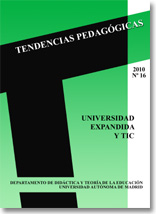Keywords:
Open Education, Open Educational Resources, Free Software, Higher Education, Educational Innovation.Copyright (c) 2015 Tendencias Pedagógicas

This work is licensed under a Creative Commons Attribution-NonCommercial 4.0 International License.
Abstract
The "open learning" is based on the concept of free knowledge and inspired by the movement of "Free Software". Its purpose is to get anyone in the world with Internet access to scientific, academic and cultural human knowledge, freely available, without economic, technical or legal restriction. The "Open Educational Resources" are digital materials that provide non-discriminatory access and can be adapted, revised and shared. They consist of learning content, technology tools and implementation resources. The MIT initiative, called OpenCourseWare (OCW), was a pioneer in the online publication of teaching materials for subjects belonging to different official degrees from MIT, with free access through the Web. The practical realization of the principles surrounding the "Open Educational Resources" requires the use of computer applications that facilitate the creation of products under open formats and standards. The universities meet in free software solutions for your learning management, especially through the so-called LMS (Learning Management Systems) and Moodle. Also, performance of groups developing free software offers lessons for innovation in higher education.Downloads
References
Abelson, H. (2007). The Creation of OpenCourseWare at MIT, Journal of Science Education and Technology, 17 (2), 164-174.
Antonacci, F. (2004). Free software development communities as a pedagogic model, MIT: Free/Opensource Research Community. Disponible en
Atkins, D. Brown, J.S. & Hammond, A.L. (2007). A Review of the Open Educational Resources (OER) Movement: Achievements, Challenges, and New Opportunities, San Francisco: Hewlett Foundation. Disponible en
http://opensource.mit.edu/papers/antonacci.pdf].
http://www.oerderves.org/wp-content/uploads/2007/03/a-review-ofthe-open-educational-resources-oer movement_final.pdf
Bryceson, K. (2007). The online learning environment. A new model using social constructivism and the concept of 'Ba' as a theoretical framework, Learning Environments Research, 10 (3), 189-206.
Centro de Recursos de Información y Software Libres (2008). Estudio para la sustitución de software privativo por software libre en las Aulas Informáticas Generales, Madrid: Vicerrectorado de Infraestructuras, Calidad y Medioambiente de la Universidad Carlos III. Disponible en http://www.cica.es/PDFS/Impresos/IRISLIBRE.pdf
CRUE (2006). Marco para el Intercambio de Documentos en Universidades Españolas mediante Estándares Abiertos. Disponible en http://crueic.uji.es/index.php?option=com_remository&Itemid=28&func=startdown&i
d=109
Dalziel, J. (2008). Learning Design: Sharing Pedagogical Know-How. En Iiyoshi, T. & Kumar, M.S. Vijay (Eds.) (2008). Opening up education. The Collective Advancement of Education through Open Technology, Open Content, and Open Knowledge, Cambridge: MIT Press. [http://mitpress.mit.edu/catalog/item/default.asp?ttype=2&tid=11309&mode=toc]
Figuerola, C.G.; Alonzo, J.L.; Zazoy, A.F. y Rodríguez, E. (2007). El uso de software libre en los sitios web universitarios españoles. Disponible en http://reina.usal.es/pub/figuerola2007uso.pdf
Fitzgerald, B. (2006). Open Licensing (OCL) for Open Educational Resources. Disponible en http://www.oecd.org/edu/oer
González-Barahona, J.M., Chaparro, D.; López, L; Romera, T. y Cañas, L. (2004). Edukalibre: una herramienta para la creación colaborativa de
materiales didácticos. Disponible en http://edukalibre.org/documentacion/edukalibre_ctsl.pdf
Hertel, G. (2002). Managing virtual teams based on models from social psychology: The VIST model. In E.H. Witte (Ed.), Sozialpsychologie wirtschaftlicher Prozesse, Lengerich: Pabst Publishers, pp. 172-202.
Hertel, G.; Niedner S. y Hermann, S. (2003). Motivation of software developers in the Open Source projects: an Internet-based survey of contributors to the Linux kernel. Research Policy, 32(7), 1159-1177.
Iiyoshi, T. & Kumar, M.S. Vijay (Eds.) (2008). Opening up education. The Collective Advancement of Education through Open Technology, Open Content, and Open Knowledge, Cambridge: MIT Press.
[http://mitpress.mit.edu/catalog/item/default.asp?ttype=2&tid=11309&mode=toc]
Margulies, A.; Sinou, V. y Thille, C. (2005). Models of Open Educational Resources: OpenCourseWarea, Sofia, and the Open Learning Initiative, Educause Research Bulletin, 22.
Myrach, T. (2005). Open Source Community Building. Disponible en
OECD (2007). Giving Knowledge for Free. The Emergence of Open Educational Resources, París: Centre for Educational Research and Innovation (CERI). Disponible en http://opensource.mit.edu/papers/sturmer.pdf].
http://www.oecd.org/dataoecd/35/7/38654317.pdf
Raymond, E.S. (2000). The Cathedral and the Bazaar. Disponible en http://www.catb.org/~esr/writings/cathedral-bazaar/cathedral-bazaar].
Uceda, J. y Barro, S. (Dirs.) (2010). Universitic. Evolución de las TIC en el sistema universitario español 2006-2010., Madrid: CRUE - Conferencia de Rectores de las Universidades Españolas.
Valverde Berrocoso, J. (2008). El software libre y las buenas prácticas educativas con TIC, Comunicación y Pedagogía, 222, 48-55.
Williams van Rooij, S. (2007). Open Source software in US higher education: Reality or illusion? Education and Information Technologies, 12 (4), 191-209.
Wiley, D. A. (2000). Connecting learning objects to instructional design theory: A definition, a metaphor, and a taxonomy. In D. A. Wiley (Ed.), The Instructional Use of Learning Objects. Disponible en http://reusability.org/read/chapters/wiley.doc
